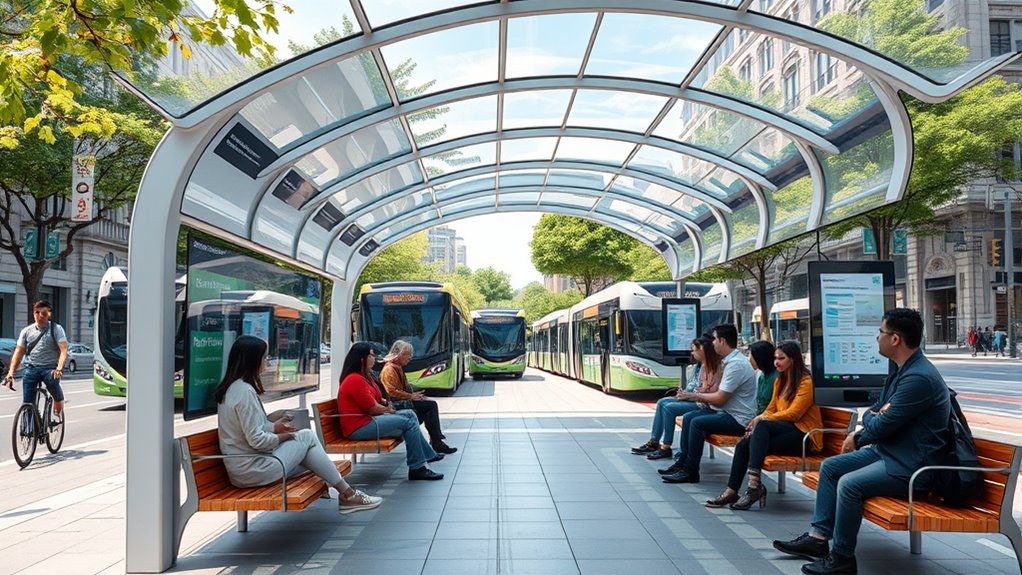Design thinking in public transportation focuses on putting your needs first, making systems more accessible and fair. It involves you in creating solutions like flexible fare policies, user-friendly station features, and inclusive designs that address real challenges you face daily. This approach encourages ongoing improvements based on your feedback, fostering trust and independence. By emphasizing your experiences, transit systems become smarter and more equitable. Keep exploring to discover how this innovative approach is reshaping your commute for the better.
Key Takeaways
- Prioritizes user needs by involving riders in designing flexible, equitable fare policies and transit features.
- Implements accessibility upgrades like low-floor buses, tactile paving, and clear signage through co-created solutions.
- Uses design thinking to identify and address commuter pain points, enhancing overall system responsiveness.
- Fosters trust and loyalty by empowering riders to participate in ongoing transit improvements.
- Transforms traditional transit systems into adaptive, inclusive services that meet diverse community needs.

Design thinking is transforming public transportation by placing user needs at the forefront of innovation. When you approach transit systems through this lens, you realize that every detail, from fare policies to accessibility improvements, directly impacts your daily commute. Instead of designing for the system’s convenience alone, transit agencies are now actively involving users like you to identify pain points and develop practical solutions. This user-centered method encourages a deep understanding of what makes transit accessible, affordable, and efficient for everyone.
One of the most visible changes driven by design thinking is how fare policies are crafted. Traditional fare structures often feel rigid and confusing, discouraging ridership among certain groups. Now, transit agencies are rethinking these policies to be more flexible and equitable. You might find options like pay-as-you-go systems, discounted fares for students or seniors, or even free rides during off-peak hours. These changes aim to lower financial barriers and make transit more inclusive. By involving riders in the design process, agencies gain insights into what discounts or payment methods work best for different communities, ensuring policies truly meet user needs. This shift not only improves affordability but also encourages more people to choose public transit over driving.
Accessibility improvements are another vital aspect of this shift. Transit systems historically overlooked the needs of people with disabilities or limited mobility. Today, through design thinking, agencies prioritize features like low-floor buses, audio-visual announcements, and wheelchair-accessible stations. You’ll notice more stations equipped with ramps, tactile paving, and clear signage that helps visually impaired riders navigate easily. These enhancements stem from engaging with diverse user groups, understanding their challenges, and co-creating solutions that remove barriers. As a result, public transportation becomes more welcoming and usable for everyone, fostering a sense of independence and dignity. This approach also benefits parents with strollers, elderly passengers, and anyone facing mobility issues, making the entire system more equitable. Additionally, emphasizing user involvement in the design process ensures ongoing improvements align with actual needs.
Ultimately, design thinking transforms public transit into a service that adapts to your needs rather than forcing you to adapt to it. By focusing on user experience, agencies develop fare policies that are fair and accessible, and they implement accessibility improvements that create a more inclusive environment. This process fosters trust and loyalty among riders because they see their feedback reflected in tangible changes. As a commuter, you become an active participant in shaping transit solutions, ensuring that the system evolves to serve you better. In the end, putting people first leads to smarter, more responsive public transportation that benefits everyone.
Frequently Asked Questions
How Can Design Thinking Improve Transit Safety Measures?
You can improve transit safety measures by focusing on passenger behavior and emergency response. Use design thinking to observe and understand how commuters act in different situations, then develop solutions that encourage safer behavior. Incorporate passenger feedback to identify safety gaps, and prototype quick, effective emergency response systems. This approach makes safety measures more user-friendly, increasing compliance, and ultimately creating a safer environment for everyone on transit.
What Role Does Community Feedback Play in Transit Design?
Community feedback plays a essential role in transit design by ensuring solutions meet your needs. Engaging with community members creates valuable feedback loops, allowing you to voice concerns and suggest improvements. Some might think feedback slows progress, but it actually streamlines it by addressing issues early. You benefit from safer, more efficient transit systems when your input is actively incorporated into the design process, making public transportation more responsive to your daily commute.
How to Measure Success in Commuter-Centric Transit Projects?
You measure success in commuter-centric transit projects by tracking performance metrics like ridership growth, on-time performance, and customer satisfaction. User engagement is also essential—monitor how passengers interact with new services or features through surveys, app usage, or feedback. When these metrics improve and engagement increases, it indicates your transit solutions effectively meet commuter needs, driving continuous improvement and a more responsive transit system.
What Challenges Hinder Implementing Design Thinking in Transit Agencies?
Think of a locked gate blocking your path. Organizational resistance and budget constraints often stand in your way when implementing design thinking in transit agencies. Resistance from staff or leadership can feel like a fortress, while tight budgets limit innovative investments. You face hurdles that require patience, dialogue, and strategic planning to open the gate. Overcoming these challenges demands persistence, aligning stakeholder interests, and demonstrating value to gain buy-in for commuter-centric solutions.
How Does Design Thinking Adapt to Technological Advancements in Transit?
You adapt to technological advancements by focusing on smart integration and user personalization. Embrace new tools like real-time data and mobile apps to enhance the commuter experience. Use design thinking to test innovative solutions that seamlessly connect technology with user needs. By continuously iterating, you guarantee transit systems evolve with tech, making journeys more efficient and personalized, ultimately increasing satisfaction and ridership.
Conclusion
Embracing design thinking in public transportation is like planting a seed that grows into a thriving, commuter-centric tree. By listening to your needs, you help shape transit solutions that are more accessible, efficient, and user-friendly. When you prioritize the rider’s experience, you’re cultivating a system that blooms with innovation and responsiveness. Together, we can turn transportation challenges into opportunities, creating a network that truly serves everyone’s journey—because every trip is a step toward a better future.









